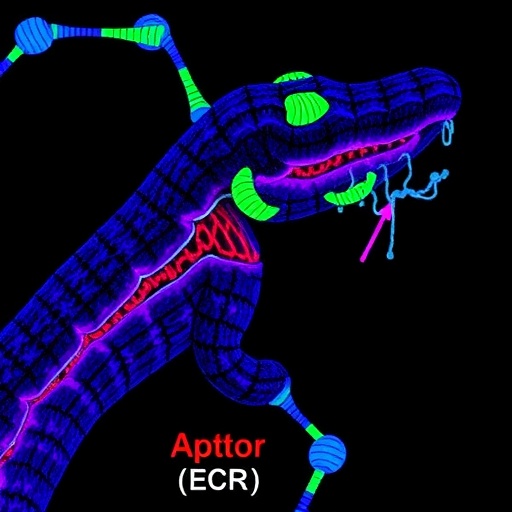In a groundbreaking advance that reshapes our understanding of cancer biology, a team of researchers has successfully leveraged genome-wide in vivo CRISPR screens to illuminate a crucial tumor suppressor mechanism within Myc-driven lymphoma—a notoriously aggressive cancer subtype. This work uncovers the GATOR1 complex as a potent tumor suppressor, illuminating a previously hidden regulatory axis that restrains the oncogenic power of Myc, one of the most frequently deregulated oncogenes in human cancer. The study provides a compelling molecular framework and opens exciting prospects for targeted therapeutic interventions in lymphomas characterized by Myc overexpression.
The oncogene Myc plays a pivotal role in regulating cell proliferation, metabolism, and apoptosis, but its dysregulation unleashes a torrent of aberrant cellular processes culminating in malignancy. Despite extensive research efforts, effective therapeutic strategies to counter Myc-driven cancers remain elusive because Myc itself is considered “undruggable.” Therefore, functional genetic screens aimed at uncovering synthetic lethal partners or tumor suppressors that cooperate with Myc represent a strategic pathway toward translational breakthroughs.
Exploiting the revolutionary CRISPR-Cas9 genome editing technology, Potts and colleagues adopted an innovative in vivo screening approach that surpasses the limitations of traditional in vitro models. By introducing a genome-wide CRISPR library directly into living lymphoma models, the research team interrogated the entire murine genome for genes whose loss potentiates or suppresses Myc-driven tumorigenesis. This exhaustive, unbiased strategy empowers the discovery of physiologically relevant tumor suppressors acting within the intact cellular and microenvironmental context of lymphoma development.
The GATOR1 complex, comprising DEPDC5, NPRL2, and NPRL3, emerged as a top hit from these screens, pinpointing it as a critical tumor suppressor nexus. Prior to this study, GATOR1 was chiefly recognized for its canonical role in nutrient-sensing and mTORC1 signaling—a pathway often hijacked by cancer cells to sustain unchecked growth. The discovery that GATOR1 loss accelerates Myc-driven lymphoma progression substantiates a model where GATOR1 functions as a cellular brake to metabolic reprogramming induced by Myc oncogene activation.
Intriguingly, mechanistic investigations revealed that disruption of GATOR1 components unleashes hyperactive mTORC1 signaling, culminating in elevated anabolic metabolism and augmented tumor cell proliferation. This hyperactivation compromises cellular homeostasis and favors a metabolic environment conducive to oncogenesis. These findings underscore the functional interplay between metabolic pathways and oncogenic transcription factors, highlighting the therapeutic potential of targeting mTORC1 downstream effects in Myc-driven malignancies.
Using sophisticated genetic mouse models and RNA sequencing, the study delineated how GATOR1 loss reshapes the transcriptional landscape of lymphoma cells. Specifically, GATOR1 deficiency amplifies expression of genes involved in ribosome biogenesis, nucleotide synthesis, and mitochondrial function—hallmarks of a hyperproliferative state. This transcriptional reprogramming converges on amplifying Myc’s oncogenic output, thus establishing a feed-forward loop that fosters lymphoma aggressiveness.
The translational implications are profound. mTORC1 inhibitors, such as rapamycin analogs, are already clinically available, and this study provides a strong rationale for their repurposing in subsets of lymphoma patients whose tumors exhibit compromised GATOR1 function. Moreover, these findings advocate for the development of precision medicine strategies that integrate tumor genetic profiling with metabolic vulnerabilities.
Importantly, the in vivo CRISPR screening methodology demonstrated here sets a new standard for cancer functional genomics. By preserving the tumor microenvironment and immune interactions, this platform yields findings with greater clinical relevance than conventional cell culture-based screens, which often fail to recapitulate the complexity of tumor biology in living organisms.
These insights into GATOR1’s tumor-suppressive role also prompt reevaluation of metabolic checkpoints in oncogenesis more broadly. Given that Myc deregulation occurs across a wide spectrum of cancers, it is plausible that GATOR1-mediated mTORC1 control represents a conserved tumor suppressive mechanism beyond lymphoma, warranting broader investigation.
The work also raises intriguing questions about how metabolic stress and nutrient sensing intersect with oncogenic signaling pathways. The GATOR1 complex, by virtue of its nutrient-sensing capabilities, may link extracellular environmental cues with intracellular oncogenic circuits, thereby influencing cancer cell adaptability and survival during tumor progression.
Moreover, this study exemplifies the power of systems biology approaches that integrate genetic screening, metabolic analysis, and transcriptional profiling to decode cancer vulnerabilities. Such holistic frameworks are essential to unravel the multifaceted nature of oncogene addiction and resistance mechanisms that underlie clinical challenges.
While the therapeutic landscape for Myc-driven lymphoma remains challenging, the identification of GATOR1 as a tumor suppressor provides a concrete molecular handle for drug development efforts. It is conceivable that combinatorial regimens targeting both Myc-associated transcriptional programs and mTORC1 signaling could yield synergistic anti-tumor effects, potentially overcoming resistance that plagues monotherapies.
This research also contributes to our understanding of how cancer cells exploit metabolic rewiring to thrive under oncogenic stress. By targeting the metabolic dependencies forged by Myc overactivation, future interventions may achieve higher specificity and reduced toxicity.
Beyond cancer, the role of the GATOR1 complex in nutrient sensing and metabolism suggests broader physiological implications, raising the possibility that its dysfunction could contribute to other pathological states linked to mTOR dysregulation. This opens a fertile area for further biomedical inquiry.
As genome editing tools continue to evolve, the integration of in vivo CRISPR screens with single-cell sequencing and spatial transcriptomics promises to accelerate discovery of tumor suppressors with unprecedented resolution. Studies like this herald a new era where functional genomics merges seamlessly with cancer therapeutics.
In summary, Potts, Mizutani, Deng, and colleagues have delivered a seminal contribution by revealing GATOR1 as a pivotal tumor suppressor within Myc-driven lymphoma, strategically connecting metabolic regulation with oncogenic transcription. Their work not only charts new territory in cancer biology but also lays the foundation for novel therapeutic strategies that may someday translate into tangible benefits for patients afflicted by these aggressive malignancies.
Subject of Research: Identification of tumor suppressor genes in Myc-driven lymphoma using genome-wide in vivo CRISPR screens
Article Title: Genome-wide in vivo CRISPR screens identify GATOR1 complex as a tumor suppressor in Myc-driven lymphoma
Article References:
Potts, M.A., Mizutani, S., Deng, Y. et al. Genome-wide in vivo CRISPR screens identify GATOR1 complex as a tumor suppressor in Myc-driven lymphoma. Nat Commun 16, 7582 (2025). https://doi.org/10.1038/s41467-025-62615-y
Image Credits: AI Generated




